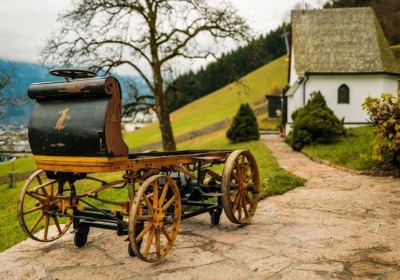The Porsche P1 is lighter, greener and more exclusive than McLaren's new hypercar
Mon, 27 Jan 2014
Long before the legendary Porsche 911 -- before, even, the Porsche 356 -- Ferdinand Porsche was tinkering with alternative powertrains and designing road-worthy vehicles.
Though it wasn't the first vehicle to bear his name, the “Egger-Lohner electric vehicle, C.2 Phaeton model” was the earliest result of his efforts. Perhaps getting the jump on the modern alpha-numeric craze/plague, it was shortened to a simple “P1.”
The P1 (we'll refer to it as the Porsche P1 from here on out to avoid confusion) made its first appearance in Vienna on June 26, 1898, and it didn't last long in the public eye: Before Porsche decided to pull it out and put it on display, it had reportedly been sitting in a warehouse, untouched, since 1902.
Of course, there's another car with the same name making headlines these days -- the 2015 McLaren P1. Everyone in the automotive enthusiast world is currently dazzled by Woking's newest hypercar, but a quick glance at the ol' Egger-Lohner's stats reveal a few areas where it's still got the edge, more than a century on.
Porsche
The 12-volt motor capable of propelling the Porsche-designed P1 to speeds as high as 21 mph.
-- First, weight: The wood-framed Porsche P1 beats out the carbon fiber-laden McLaren P1 in the race for ultimate hyperleggera cred. The former car weighs just 2,977 lbs; the latter, a porky 3,075 lbs.
-- Much has been said about the new crop of hybrid hypercars, which includes the 918 Spyder. But the Porsche P1 does these tarted-up Priuses one better: It's all-electric, all the time. Its 12-volt, 287-lb electric motor sits at the rear of the car just inches from the ground -- can you say “low center of gravity”? The McLaren stays glued to the ground with active aerodynamics and a gigantic rear spoiler, but Porsche accomplished the same thing with effective weight distribution.
-- Cruise control! The Porsche P1 has cruise control! We assume the McLaren P1, which we found to be surprisingly well-mannered at legal speeds, has that feature as well. But come on -- we're talking about a car from 1898. A driver could select one of 12 speeds and just cruise, at least for approximately 49 miles.
-- Wooden wheels with pneumatic tires can be repaired in a workshop with sandpaper and varnish. Curb the rollers on your McLaren once and they'll never look like new ever again. Plus, the Porsche's mechanical band brake/electrical short circuit brake just has to be cheaper to maintain than the Akebono carbon-ceramic units on the McLaren.
-- We'd be remiss if we didn't note the output deficit on the part of the Porsche P1. Compared to the McLaren's 903 hp, the Porsche puts out just 3 all-electric hp. But! There's an overdrive mode that permits 5 hp for limited periods of time. 0-60 times are irrelevant; the vehicle's top speed is just 21 mph. But you know what they say about driving a slow car fast…
-- As with the McLaren P1, the Porsche P1's 'Ring time remains a mystery -- but we do know the car has a proven history of motorsport success. On Sept. 28, 1899, Ferdinand Porsche walked the competition in a 24-mile race in Berlin; with three passengers on board, he still managed to cross the finish line 18 minutes ahead of the competition.
-- We've heard that the McLaren's 375 units are already completely sold out. Ferdinand Porsche scoffs at British notions of exclusivity; “approximately four” of his P1s were ever made.
If you wish to marvel at this late-Victorian era wonder, you'll have to head to the Porsche Museum in Stuttgart. It's worth the trip.
Porsche
When men were men and instrument clusters consisted of but two dials.
By Graham Kozak

